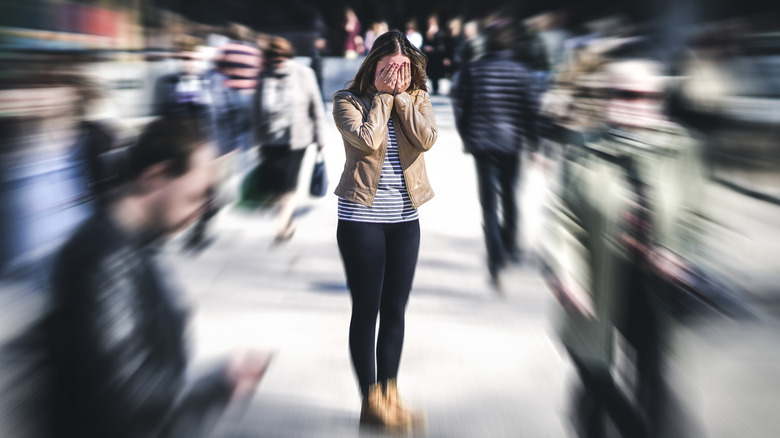What It Really Means When You Have Agoraphobia
Though agoraphobia has become more discussed and recognized in recent years, there's still confusion surrounding exactly what it means. It's commonly thought that agoraphobia is simply a fear of being in open spaces, but it's much more detailed than that. First and foremost, agoraphobia is an anxiety disorder — one of which you may exhibit the signs for (via WebMD). People afflicted with it become fearful of being stuck in situations they either can't get out of or can't control.
Common places where fears arise in those who have agoraphobia include public transportation, such as being on trains, buses, and planes, as well as any place where there are long lines or crowds, like a supermarket or a shopping mall. Other places that stir up fear are open spaces like parking lots and closed-in spots like offices and theaters. Typically, agoraphobia affects women more than men, per the Mayo Clinic. Though the anxiety disorder can appear at any age, it typically affects people between the ages of 25-35 (via MedicalNewsToday).
Symptoms of agoraphobia
Signs that a person may have agoraphobia aren't always clear, and sometimes they can start out as simple preferences. In the early stages, the person might just avoid crowds and small spaces, but as the anxiety grows to the point where they're anxious all day, they may not want to leave the house at all (via Mayo Clinic).
In the beginning, people may start to feel anxious while they're in places they normally go, like school, work, shopping, or other social events. They may notice a fast heartbeat, feel dizzy, sweaty, shaky, and get the chills. They may also get nauseated or have diarrhea. As the anxiety grows and they continue to feel trapped in the situation, they may feel like they're dying because they don't know what's happening to their body. This is also what a panic attack feels like and people prone to agoraphobia are also prone to panic attacks (per Mayo Clinic).
Since the feeling of being out of control is so severe, people soon begin to avoid more and more public places, until eventually, they may fear leaving their homes completely.
Agoraphobia can be treated
Though the causes of agoraphobia aren't fully understood, researchers believe there's a strong genetic component to the condition. It can occur more often in people whose families have a pathological tendency for phobias (via Psychology Today). Yet agoraphobia can also happen after a very stress-induced life situation, like the death of a loved one or another traumatic experience.
Luckily, treating agoraphobia usually has high success rates, though each case is individual and has a different level of intensity. Treatment typically involves cognitive behavioral therapy to help address contributing stressors by recognizing what thoughts bring about fear and dread. Another treatment option is exposure therapy which allows the patient to slowly be incrementally exposed to fearful situations in an attempt to desensitize them to each frightening surrounding. In severe cases, medications such as "selective serotonin reuptake inhibitors (SSRIs) or serotonin-norepinephrine reuptake inhibitors (SNRIs)" may be prescribed (via Cleveland Clinic).
Lifestyle changes that alleviate stress and anxiety can also help agoraphobia, including eating a healthy nutritious diet, getting regular movement, limiting caffeine, and practicing mindfulness.


